Vol. 9 No. 5
“UNDER NO CIRCUMSTANCES attempt to hike down to the Colorado River & back in one day” National Park Service
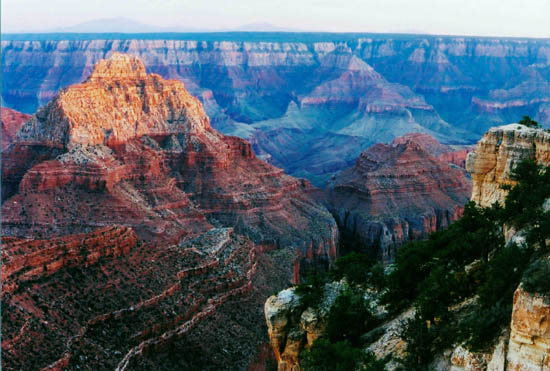 In the darkness of the night, the National Park Service “in your face” warning sign, posted at Bright Angel trailhead, wasn’t visible. We weren’t concerned, the three of us were familiar with the Canyon’s trails and physically conditioned for the ultra “rim to rim to rim” round trip. We had successfully made this challenging hike five years ago and this time, we were better prepared, both physically and mentally. Or so we thought.
In the darkness of the night, the National Park Service “in your face” warning sign, posted at Bright Angel trailhead, wasn’t visible. We weren’t concerned, the three of us were familiar with the Canyon’s trails and physically conditioned for the ultra “rim to rim to rim” round trip. We had successfully made this challenging hike five years ago and this time, we were better prepared, both physically and mentally. Or so we thought.
Tucsonan David Lovitt, my son-in-law, Matt Figueroa and I planned to descend 8-miles to the Colorado River then climb 16 tortuous miles to the North Rim. We would backtrack to our starting place at the South Rim. Yes, we were undertaking a non-stop trek of almost 50-miles, including almost 12 hours of hiking in the darkness of the night.
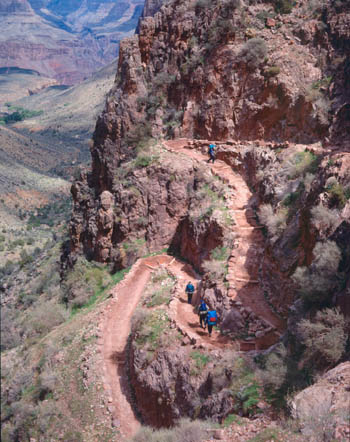 Leaving Maswik Lodge at 3:30 on an chilly (28-degrees) October morning, we walked the short distance to the South rim. Matt led us in a prayer before leaving the trailhead. He hikes a faster pace, taking off leaving David and me to navigate on our own.
Leaving Maswik Lodge at 3:30 on an chilly (28-degrees) October morning, we walked the short distance to the South rim. Matt led us in a prayer before leaving the trailhead. He hikes a faster pace, taking off leaving David and me to navigate on our own.
The Grand Canyon’s Rim to Rim to Rim hike is the ultimate physical challenge. The trail has a total altitude change of 20,000 feet: 4500 on the South rim and 5500 on the North.
As we descended Bright Angel Trail, a brisk wind penetrating our light clothing was chilling. From prior experience, we knew the 4500-foot descent would warm us in the next half-hour. Not wanting to carry one extra ounce in our backpacks, we left our jackets behind.
We were confident that our cross training regime for the past five months would allow us to succeed. Conditioning muscles and especially feet during the blast furnace heat of an Arizona summer had given us “more training bang for the buck”. Hiking one of my favorite trails in the 110-degree summer heat of Phoenix for 3.5 hours was equivalent to hiking 5 hours during Fall’s more tolerable temperatures.
That ominous Park Service trailhead sign also warns about dehydration. We hydrated before, during and after our hikes drinking our own recipe of a Gatorade/Accelerade mix to replenish our body electrolytes.
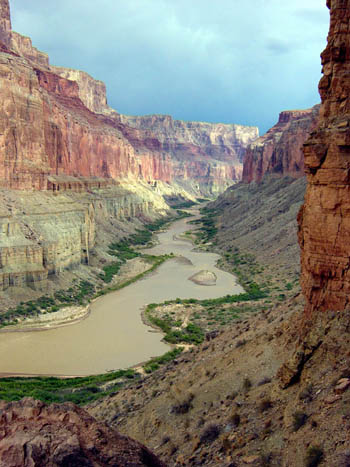 We trained every other day making a longer hike on the weekends. Several times, Matt and I traveled to Tucson to train in David’s hometown, and to experience the great variety of trails in the Catalina Mountains. My wife Susan and I also traveled to northern Arizona’s city of Flagstaff to hike Mt. Humphries, the highest point in Arizona (12,000′), a peak higher than Japan’s Mt. Fuji.
We trained every other day making a longer hike on the weekends. Several times, Matt and I traveled to Tucson to train in David’s hometown, and to experience the great variety of trails in the Catalina Mountains. My wife Susan and I also traveled to northern Arizona’s city of Flagstaff to hike Mt. Humphries, the highest point in Arizona (12,000′), a peak higher than Japan’s Mt. Fuji.
An unmerciful and unrelenting Phoenix sun beat down on us during one weekend “death march”, a 20-mile hike along unforgiving trails. Starting before dawn, we climbed Shaw Butte (2149′) then backtracked through the valley’s open desert (elevation 1200′) to climb Squaw Peak (elevation 2608′). Our return hike followed essentially the same route, except we also climbed, Shaw Butte’s neighbor, North Mountain elevation 2104′. After eight hours of training in the punishing heat, we were exhausted.
David and I are not exactly “spring chickens”. To celebrate our 60th year, we challenged ourselves with a goal to hike rim to rim to rim in the Grand Canyon in less than 24 hours. If we encountered great weather, we wanted to better our personal best time (set five years ago) of 20 hours. Matt didn’t share his goal with us, but we knew that his youth and superb conditioning would enable him to obliterate his previous record.
Grand Canyon’s trails are excellent, better than those we used for training. Well groomed and patrolled, the Park Service is constantly clearing and maintaining them to keep them in great shape. Directional signs are also superb; there is little chance of taking the wrong fork along the way.
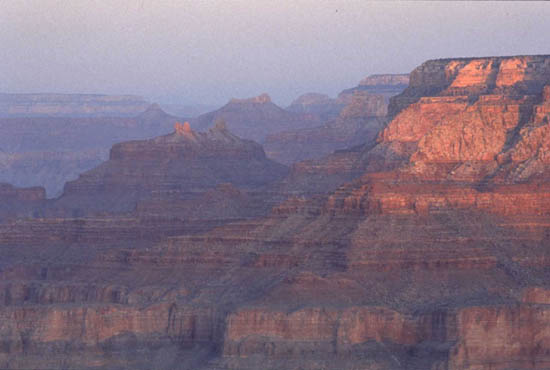 Hiking in the dark, while a tad spooky, doesn’t feel much different than hiking trails in Phoenix. It’s as if you are no longer in the Canyon, just trucking along any generic trail. Visibility in the Grand Canyon extends as far as the light from your flashlight.
Hiking in the dark, while a tad spooky, doesn’t feel much different than hiking trails in Phoenix. It’s as if you are no longer in the Canyon, just trucking along any generic trail. Visibility in the Grand Canyon extends as far as the light from your flashlight.
David and I had planned to buddy-up. After a lifetime of friendship, this hike would bond us even closer. We knew Matt would be ahead of us on the trail and his athletic success enhanced our excitement.
The Grand Canyon is one of the Seven Wonders of the World, but our arduous hike overshadowed some of its incredible beauty. We did take time to appreciate a stand of Aspen trees in the midst of autumns requisite color change and when sunrise or sunset illuminated an especially stunning peak or promontory.
We made good time on the Canyon’s sometime rocky trail reaching Indian Gardens in about two hours. We later learned by the time we arrived at Indian Gardens, Matt was at Phantom Ranch, at the bottom of the Canyon at. He was traveling at a pace almost twice as fast.
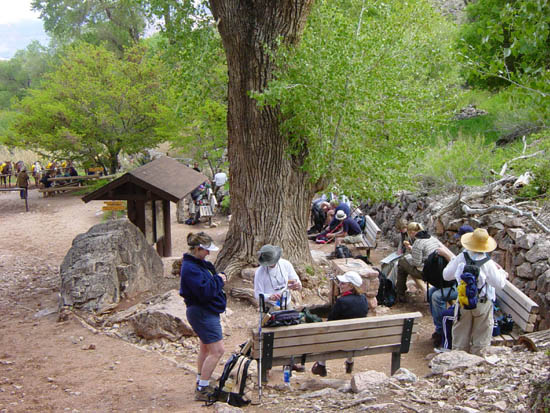 Devil’s Corkscrew consists of two miles of switchbacks, through narrow canyons opening where the bridge spans the Colorado. As we arrived, the sun was just peaking over the rim.
Devil’s Corkscrew consists of two miles of switchbacks, through narrow canyons opening where the bridge spans the Colorado. As we arrived, the sun was just peaking over the rim.
Arriving at Phantom Ranch, we quickly gulped several Power Bars and water. The historic Ranch is the only place offering meals and lodging below the canyon rim. Unfortunately, we didn’t have time to enjoy its accommodations. We pressed on to Cottonwood, the last place we would be able to reload our water. In order to prevent freezing temperatures from bursting water pipes, the Park Service shuts off water sources on the North Rim when the weather turns cold As luck would have it, we would not have water access. They had stopped the flow three days prior to our hike.
We passed hundreds of other hikers, some appearing very young. We paused to chat with a couple who told us about two organized and supported groups: one included about a hundred hikers; the another included 30 Boy Scouts doing a rim to rim hike (our hike covered twice their distance) We moved quickly exchanging greetings; knowing, by their appearance, that some would find the going tough later on.
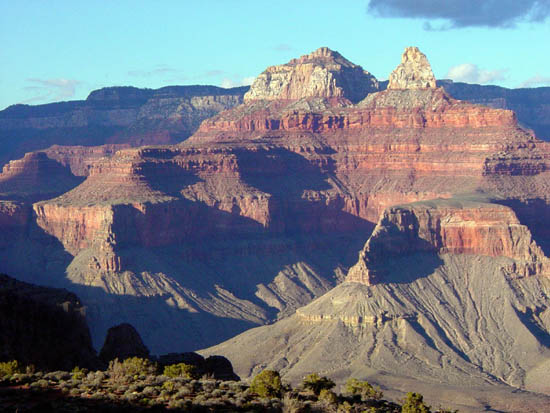 Halfway between Phantom Ranch and the North Rim is the Cottonwood Campground. Its tall cottonwoods are recognizable from a distance. The permit-required campground is a wide place in the trail with running water and bathroom facilities. Camping sites include critter-proof food storage boxes. A creek gurgles between canyon walls about 50 yards away.
Halfway between Phantom Ranch and the North Rim is the Cottonwood Campground. Its tall cottonwoods are recognizable from a distance. The permit-required campground is a wide place in the trail with running water and bathroom facilities. Camping sites include critter-proof food storage boxes. A creek gurgles between canyon walls about 50 yards away.
The strenuous climb to the North Rim began at Roaring Springs. As we looked up to our lofty objective, we spied Matt on his way down. He had already summited and was on his way back. The echo of our cheering embarrassed him, but not enough to slow running strides that quickly closed the gap between us.
Matt took time to tell us that he was feeling strong. He told us that he’d hidden his pack at The Bridge (some 4 miles from the rim), taking only an energy bar and bottle of Gatorade to the top (to lessen the weighty burden). What a great idea! We high-fived one another, and continued on our separate ways.
We dreaded those two big climbs to the North and South rim, and they were as tough as we expected. I began to feel a twinge of pain in my knees and back as we reached Supai Tunnel about an hour later. The short, carved rock tunnel has toilets and a drinking fountain that had been turned off. After a moment’s quick relief, we began the final two-mile grunt to the rim. 11 hours after departing the South rim, we arrived at the North rim taking a mere 10 minutes for a short rest and refueling snack. Finding a relatively flat place to lie down, we crashed as the harmony of our groans made us laugh.
 We were halfway to our goal. Heading back to the South rim, we discovered that descending felt surprisingly easier. We were using different muscle groups than those that had powered the grind up. Both of us slipped several times, those dirt-coated rocks played havoc with our footing. Thankfully, my hiking poles saved me several times and afforded an additional source of balance in rutted places.
We were halfway to our goal. Heading back to the South rim, we discovered that descending felt surprisingly easier. We were using different muscle groups than those that had powered the grind up. Both of us slipped several times, those dirt-coated rocks played havoc with our footing. Thankfully, my hiking poles saved me several times and afforded an additional source of balance in rutted places.
Encountering other hikers, ones we had passed earlier, they suddenly realized that we were doing the “hike from hell”, the Rim to Rim to Rim. They gave us strong encouragement offering us luck as they expressed admiration of our unenviable quest.
Arriving back at Aiken’s Home, a comfortable, picturesque and unassuming place tucked in a grove of trees next to Roaring Springs Creek, just short of Cottonwood, it became apparent that the sunlight was fading more quickly than we anticipated. We would soon be trudging along in the dark. Both of us had new batteries in our flashlights and our familiarity with the trail gave us no concern. Passing Cottonwood, the couple we’d encountered on the trail that morning (the folks who told us about the people on the trail) called out, “way to go guys, stay strong”. We waved our thanks and plodded on.
Switching on our flashlights, I discovered that for some unknown reason my new batteries were dead. David shined his more powerful flashlight and we both continued safely.
Four miles later, we were making good time as we neared The Box. This portion of the canyon is very narrow with high, vertical, very dark canyon walls. We could see stars in a strip overhead, but these pinpoints of light were virtually useless.
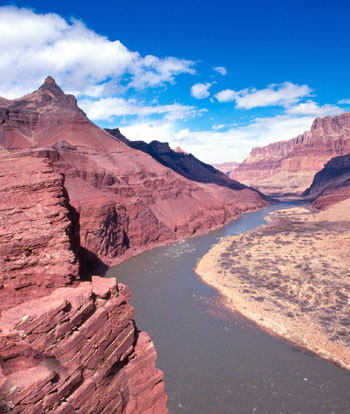 Suddenly, David’s light began to noticeably fade. We realized that soon we would be without light on this moon-less night. The final section of our hike would be made in the dark and I was still carrying only sunglasses. There was consolation knowing that Susan and her friend Tracy were waiting at Indian Gardens with food, my daylight prescription glasses and my headlamp. But, for now, we were in the darkest part of the Canyon.
Suddenly, David’s light began to noticeably fade. We realized that soon we would be without light on this moon-less night. The final section of our hike would be made in the dark and I was still carrying only sunglasses. There was consolation knowing that Susan and her friend Tracy were waiting at Indian Gardens with food, my daylight prescription glasses and my headlamp. But, for now, we were in the darkest part of the Canyon.
When David’s light failed completely, he suggested that I put the batteries from my defunct flashlight into the other hoping it might be a bulb problem. Before making the switch, I automatically twisted the light’s on/off mechanism and was surprised to find that it worked. David felt that we had luckily garnered some residual power from the rested batteries and was anxious to take advantage of our good fortune. I, on the other hand, considered it a miracle.
We picked up our pace racing against our failing battery power. As we neared Phantom Ranch, the light turned yellow for the remaining distance.
Arriving at 8:15 p.m., Phantom Ranch’s canteen and store was still open. We bought new batteries and stopped 15 minutes for dinner. The flavor of Phantom’s legendary lemonade was especially refreshing. With lights flaming brightly again, we began the 5-mile uphill climb to Indian Gardens, and a happy and welcomed reunion with Susan and Tracy
 There wasn’t any way to communicate that we were running three hours later than planned. They had to be in a panic as they sat in the darkness watching for our lights. Susan said that they had run out of words and huddled motionlessly sharing each other’s warmth as they stared into the black for our flashlights.
There wasn’t any way to communicate that we were running three hours later than planned. They had to be in a panic as they sat in the darkness watching for our lights. Susan said that they had run out of words and huddled motionlessly sharing each other’s warmth as they stared into the black for our flashlights.
Two miles up the trail, David suffered a debilitating stomach ache. His stabbing pains forced us to stop as he doubled over and dug into his first aid pack for some prescription strength relief. 15 minutes later, the pain somewhat abated and we again we plodded on.
Hobbling into Indian Gardens about 11:30pm, we were greeted by two ecstatic women. After a short period where human relief transcended the venting of the worry we had caused, we hydrated and began our final leg.
My headlamp turned night into day. Having both hands free was especially useful in allowing me to take better advantage of my hiking poles. We pushed on, somewhat renewed.
Two minutes later, my headlamp abruptly died. I was speechless. Thirty minutes later, David’s fresh batteries died. How weird was this? Luckily, Susan and Tracy’s lights provided enough light along the trail for the four of us.
We divided the final 4.7 miles into thirds. We did the first mile and a half at a pace so fast the women, who are in great shape, were huffing and puffing by the time we reached the first rest house. After a water break, we slowed our pace. When we reached the final pitch of the trail, my strength was sapped. It felt as if body fat was fueling me. Just placing one foot in front of the other was torturous. Forward progress became lurching, stumbling steps as we slowly closed in on the South Rim just before three in the morning.
What a wonderful feeling to have the pain diminished by flat ground and to have completed the hike in this majestic place. Completely exhausted and totally drained, we failed to recognize my car sitting in the parking lot. Matt had brought it to the trailhead to give us a ride back to Maswik Lodge – a half mile away.
Hiking the Grand Canyon rim to rim to rim is one of those accomplishments that becomes better in retrospect. David and I finished the 50-mile hike in 23 hours and Matt in 15:25. We were satisfied to have met the challenge. We came out of the Canyon without twisted ankles, dehydration or blisters. David and I were two hours slower that our previous trek, but it’ll still be one of the most storied hikes ever. Matt bettered his best time by almost 5 hours.
Exhausted, aching, reeling, there is nothing like such an overwhelming feeling of accomplishment. There was no one at the trailhead in the wee hours of the night, no throng of people cheering us on at the end of this double marathon, no one but ourselves recording it for posterity. The only spectators were an obsidian sky with brilliant stars and a deafening silence that literally screamed gratification, “You’ve made it!” This ultimate challenging hike left me convinced that, painful or not… weeping and gnashing of teeth, even experiencing minor hallucinations or not…we can all make it. That was more than enough.
National Park Service Tips:
- stay hydrated (drink plenty of water and electrolyte
- avoid hiking in the heat of the day (10am to 4pm)
- eat often (carbohydrates & salty foods)
- rest often (sit in the shade)
- get wet (wet your shirt, hat, & wear a wet bandana around your neck)
- UNDER NO CIRCUMSTANCES attempt to hike down to the river & back in one day
If you go: Xanterra, the company that handled our reservations, has a policy of “full refund 48 hours prior.” www.xanterra.com
